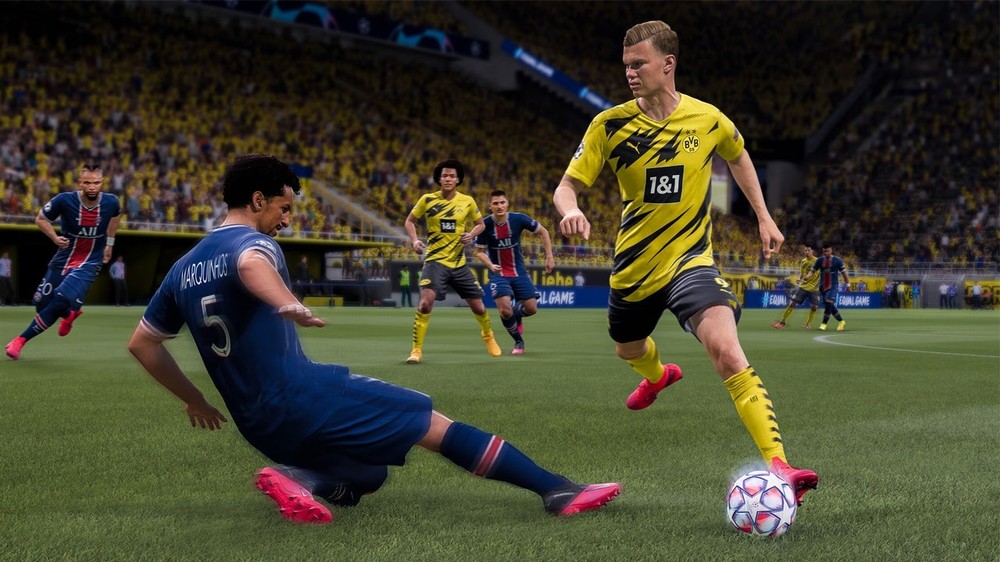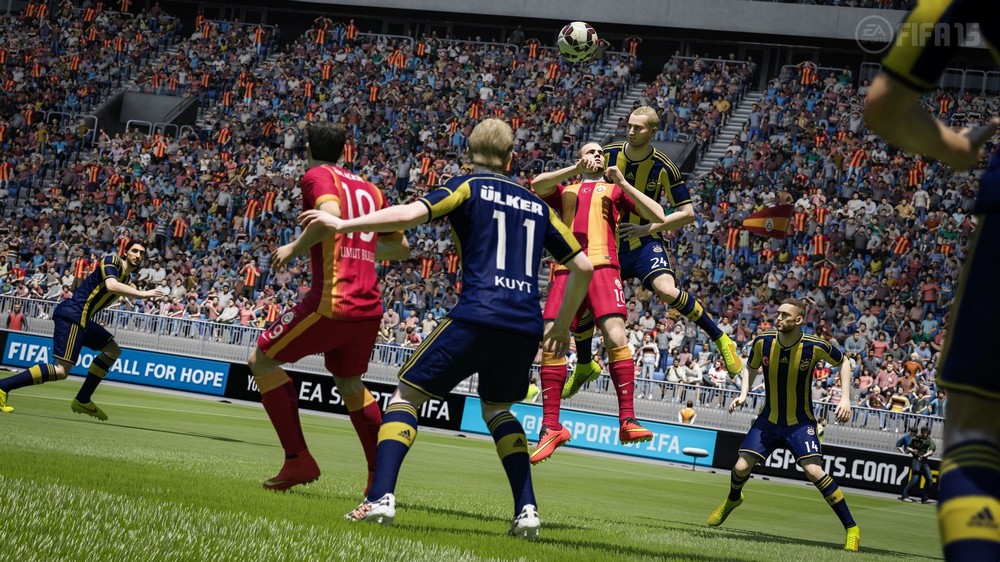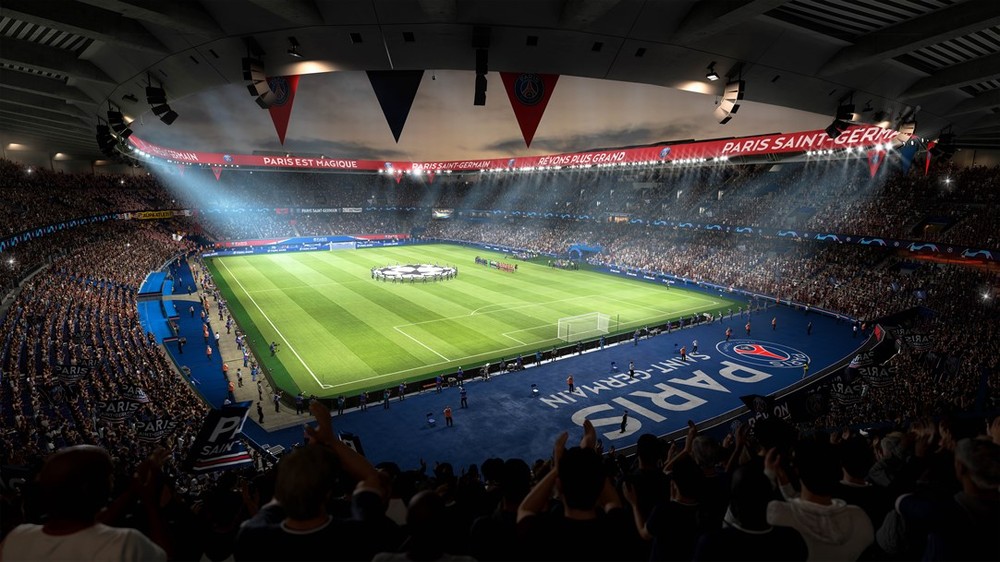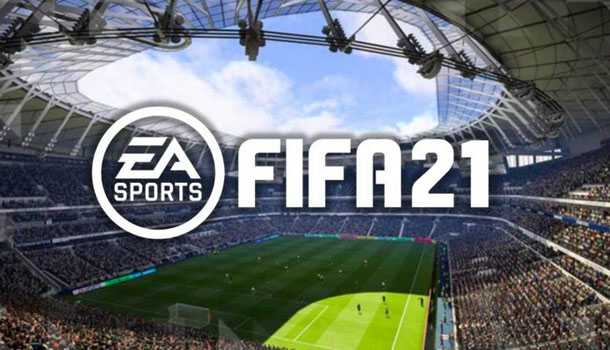One of the things that I miss most about living in England was the ability to frequently go to live football matches on a Saturday afternoon or Tuesday evening. Ironically though, living in North America actually allows me to watch more football than ever before, thanks to streaming services and strange licensing laws surrounding football in the UK. Consuming so much football through the medium of television has given me a greater appreciation for what FIFA 21 is trying to do in terms of presentation, especially when it comes to the Xbox Series X/S and PlayStation 5 versions of the game.
While some cross-generational titles have released updates to already existing titles to improve visuals or framerates, FIFA 21 for the next generation of consoles has been released as a (free to existing owners) separate title to the Xbox One and PlayStation 4 games. While this means that EA Sports has been able to tweak the FIFA match engine and overall back-end of the game to take advantage of the increased power of the newer consoles, it does also mean that the player base has been split, with the majority still playing on older machines. While for most game modes this doesn’t have too much of an effect, I did find that for a few of the lesser populated modes I was jumping back to previous gen in order to quickly find a game. This will certainly change as the number of owners of newer consoles grows, but it’s a worthwhile practice to perhaps include both versions installed on your hard drive, especially if you like to play some of the more niche modes in Ultimate Team, as this progress moves back and forth between generations.
 As an overall package, though, next-gen is easily the best place to play FIFA 21 for a number of reasons. The most impactful, but perhaps least exciting, reason is the near-eradication of load times throughout the entire game. While you will still have to wait a number of seconds to find an opponent in online modes, getting into an actual game takes a couple of seconds at most. Funnily enough, when playing online in Ultimate Team this initially caused me a bit of a shock. In previous incarnations you were able to view your opponent’s team while waiting for the game to start, allowing you to identify any weaknesses in their team or any players that might prove particularly troublesome to play against. On Xbox Series X though, the game loads so quickly that this particular screen shows for a couple of seconds at most before you’re transported into the game. It’s a similar story in Career Mode, where either practices or full games are started almost as soon as you press the corresponding button. If you play a lot of FIFA 21, these small differences will soon add up to save you a lot of time, and I certainly had a lot less time to check my phone between games.
As an overall package, though, next-gen is easily the best place to play FIFA 21 for a number of reasons. The most impactful, but perhaps least exciting, reason is the near-eradication of load times throughout the entire game. While you will still have to wait a number of seconds to find an opponent in online modes, getting into an actual game takes a couple of seconds at most. Funnily enough, when playing online in Ultimate Team this initially caused me a bit of a shock. In previous incarnations you were able to view your opponent’s team while waiting for the game to start, allowing you to identify any weaknesses in their team or any players that might prove particularly troublesome to play against. On Xbox Series X though, the game loads so quickly that this particular screen shows for a couple of seconds at most before you’re transported into the game. It’s a similar story in Career Mode, where either practices or full games are started almost as soon as you press the corresponding button. If you play a lot of FIFA 21, these small differences will soon add up to save you a lot of time, and I certainly had a lot less time to check my phone between games.
Career Mode is one area of the game that has had a number of changes made in FIFA 21 regardless of generation, and I wanted to take a couple of moments to comment on how much I feel the experience has improved. It feels a lot closer to a full management simulator now, albeit remaining on the lighter side when compared to something like Football Manager. While there’s still a lot of the DNA from previous Career Modes remaining, tweaks to systems such as training and the presentation of the calendar have gone a long way to making it feel like you have an actual itinerary as a manager. Players also suffer if they don’t play, as they start to develop a lack of match sharpness which negatively impacts their stats and similarly, if you train players too hard in an attempt to make them better it comes at a cost of their fitness. Match options have improved as well: instead of just having the option to play the entire match or leave the result to the lottery of simulating the result, you now have the ability to simulate the match but watch as it progresses, with the ability to jump in hands-on if things start to go awry. Career Mode feels like it has been neglected in recent years in favor of more lucrative modes such as Ultimate Team, but these changes make the entire experience feel like it has a little more meat on the bones, making for a more attractive proposition.
 Speaking of Ultimate Team, a number of changes have been made to the overall functionality here as well. There seems to be more focus on delivering a longer through line to the experience, with an increased number of longer-term objectives and the ability to improve and customize your own personal stadium. From the music played when a goal is scored to the color of the seats in the stands, you’re able to make your stadium your own and create your own fortress if you feel so inclined. There also seems to have been an effort made on EA Sports’ part to try and reduce the number of instances in a game that allow one player to grief another. While celebrations are still unskippable by the opposition player, a number of other meaningless animations have been removed or made skippable by both parties, which not only reduces the ability for toxic players to artificially extend the length of a game, but also means that the whole experience flows a lot better than it did before. One strange addition to the next-gen versions, though, is the inclusion of an animation when a winning goal is scored towards the end of the game, which goes on for far longer than any other cutscene. It’s a neat thing to see the first time it happens, but after one or two views it becomes more of an inconvenience, especially as it also takes longer to skip.
Speaking of Ultimate Team, a number of changes have been made to the overall functionality here as well. There seems to be more focus on delivering a longer through line to the experience, with an increased number of longer-term objectives and the ability to improve and customize your own personal stadium. From the music played when a goal is scored to the color of the seats in the stands, you’re able to make your stadium your own and create your own fortress if you feel so inclined. There also seems to have been an effort made on EA Sports’ part to try and reduce the number of instances in a game that allow one player to grief another. While celebrations are still unskippable by the opposition player, a number of other meaningless animations have been removed or made skippable by both parties, which not only reduces the ability for toxic players to artificially extend the length of a game, but also means that the whole experience flows a lot better than it did before. One strange addition to the next-gen versions, though, is the inclusion of an animation when a winning goal is scored towards the end of the game, which goes on for far longer than any other cutscene. It’s a neat thing to see the first time it happens, but after one or two views it becomes more of an inconvenience, especially as it also takes longer to skip.
Another reason why these cutscenes don’t quite have the intended impact is that despite the improvement made to player models, they still look quite lifeless once in motion. While it’s not quite as bad as the feeling from the identikit fans in the stands, there’s something about the expression on the players’ faces and their movements that betrays their digital nature. Despite this, some of the world’s greatest players look better than ever on the next generation of consoles and are instantly recognizable, be it in the new pre-game scenes or while playing a match. The improved lighting engine helps with this too, with evening games such as Champions League matches looking incredible with small details such as floodlight shadows adding an increased sense of realism to proceedings. When I was younger I remember uninitiated older family members enquiring whether the FIFA that I was playing was real football or not, and I have to say that in a number of instances, I think that I myself could be fooled by FIFA 21.
 FIFA 21 on Xbox Series X/S and PlayStation 5 reminds me a lot of the generational leap that was made with FIFA 14 when it released an updated version on PlayStation 4 and Xbox One. In terms of gameplay it feels like a generally similar beast, with crisper visuals, an overall improvement to player handling and tweaks to physics for both balls and players. On top of this, though, is the noticeable improvement to loading times that comes with this new generation, and that goes a long way to making FIFA 21 feel more seamless than ever. FIFA 21 was a worthy upgrade to FIFA 20 before the next generation update came along with the improvements that it made to gameplay and the overall experience, and the next-gen additions further enhance the value of the package. FIFA 21 on next-gen is a small but worthwhile upgrade to the overall FIFA 21 experience and will certainly be my destination going forward for my virtual footballing needs.
FIFA 21 on Xbox Series X/S and PlayStation 5 reminds me a lot of the generational leap that was made with FIFA 14 when it released an updated version on PlayStation 4 and Xbox One. In terms of gameplay it feels like a generally similar beast, with crisper visuals, an overall improvement to player handling and tweaks to physics for both balls and players. On top of this, though, is the noticeable improvement to loading times that comes with this new generation, and that goes a long way to making FIFA 21 feel more seamless than ever. FIFA 21 was a worthy upgrade to FIFA 20 before the next generation update came along with the improvements that it made to gameplay and the overall experience, and the next-gen additions further enhance the value of the package. FIFA 21 on next-gen is a small but worthwhile upgrade to the overall FIFA 21 experience and will certainly be my destination going forward for my virtual footballing needs.











